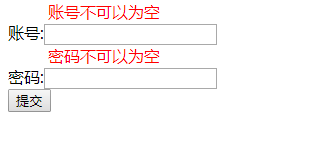Struts2框架中為什麼要繼承ActionSupport類,以及實現過程
struts可以繼承ActionSupport類,也可以不繼承,繼承的好處簡單來說就是更方便實現驗證,國際化等功能,與struts2的功能結合緊密,方便我們開發。
ActionSupport類的作用:
此類實現了很多實用的介面,提供了很多預設的方法,這些預設方法包括國際化資訊,預設的處理使用者請求的方法等,可以大大簡化action的開發,在繼承ActionSupport的情況下,必須有無參建構函式。
下面用在struts2框架搭建完成的基礎上,用 使用者請求的例子來實現ActionSupport類:
1.建立檢視層兩個頁面index.jsp和welcome.jsp頁面,下面只展示index.jsp頁面,welcome.jsp頁面的程式碼自己簡單寫一下看一下效果就行。這個jsp頁面的<s:fielderror/>
<%@ page language="java" contentType="text/html; charset=utf-8" pageEncoding="utf-8"%> <%@ taglib prefix="s" uri="/struts-tags"%> <html> <head> <meta http-equiv="Content-Type" content="text/html; utf-8"> <title>Insert title here</title> <style type="text/css"> ul,li { list-style-type:none; margin:0px; float:left; } </style> </head> <body> <form action="helloworldAction" method="post"> <input type="hidden" name="submitFlag" value="login"/> <div> <font color=red><s:fielderror fieldName="account"/></font> <br/> 賬號:<input type="text" name="account"> </div> <div> <font color=red><s:fielderror fieldName="password"/></font> <br/> 密碼:<input type="password" name="password"> </div> <input type="submit" value="提交"> </form> </body> </html>
2.實現action類封裝HTTP請求引數,類裡面應該包含與請求引數對應的屬性,併為屬性提供get,set方法,再說一次,在繼承ActionSupport的情況下,必須有無參建構函式。
validate方法內部,對請求傳遞過來的資料進行校驗,而且我們也能看出來同一個資料可以進行多方面的驗證,如果不滿足要求,內容將會在頁面上直接顯示。裡面重寫了 execute() throws Exception方法,返回字串。
package com.hnpi.action; import com.opensymphony.xwork2.ActionSupport; public class RegisterAction extends ActionSupport{ private String account; private String password; private String submitFlag; public String execute() throws Exception { this.businessExecute(); return "toWelcome"; } public void validate(){ if(account==null || account.trim().length()==0){ this.addFieldError("account", "賬號不可以為空"); } if(password==null || password.trim().length()==0){ this.addFieldError("password", "密碼不可以為空"); } if(password!=null && !"".equals(password.trim()) && password.trim().length()<6){ this.addFieldError("password", "密碼長度至少為6位"); } } public void businessExecute(){ System.out.println("使用者輸入的引數為==="+"account="+account+",password="+password+",submitFlag="+submitFlag); } public String getAccount() { return account; } public void setAccount(String account) { this.account = account; } public String getPassword() { return password; } public void setPassword(String password) { this.password = password; } public String getSubmitFlag() { return submitFlag; } public void setSubmitFlag(String submitFlag) { this.submitFlag = submitFlag; } }
3.從上面我們也可以看出來,validate方法是沒有返回值的,如果驗證不成功的話,錯誤資訊該怎麼在頁面上顯示出來呢?我們需要在struts.xml中的Action配置裡面,新增一個名稱為input的result配置,沒有通過驗證,那麼會自動跳轉回到該action中名稱為input的result所配置的頁面。
<?xml version="1.0" encoding="UTF-8"?>
<!DOCTYPE struts PUBLIC
"-//Apache Software Foundation//DTD Struts Configuration 2.0//EN"
"http://struts.apache.org/dtds/struts-2.0.dtd">
<struts>
<package name="helloworld" extends="struts-default">
<action name="helloworldAction" class="com.hnpi.action.RegisterAction">
<result name="toWelcome">/welcome.jsp</result>
<result name="input">/index.jsp</result>
</action>
</package>
</struts> 下面我們來看一下程式碼效果圖:
這個例子可以看出來,validate方法會先於execute方法被執行,只有validate方法執行後,又沒有發現驗證錯誤的時候,才會執行execute方法,否則會自動跳轉到你所配置的input所對應的頁面。

